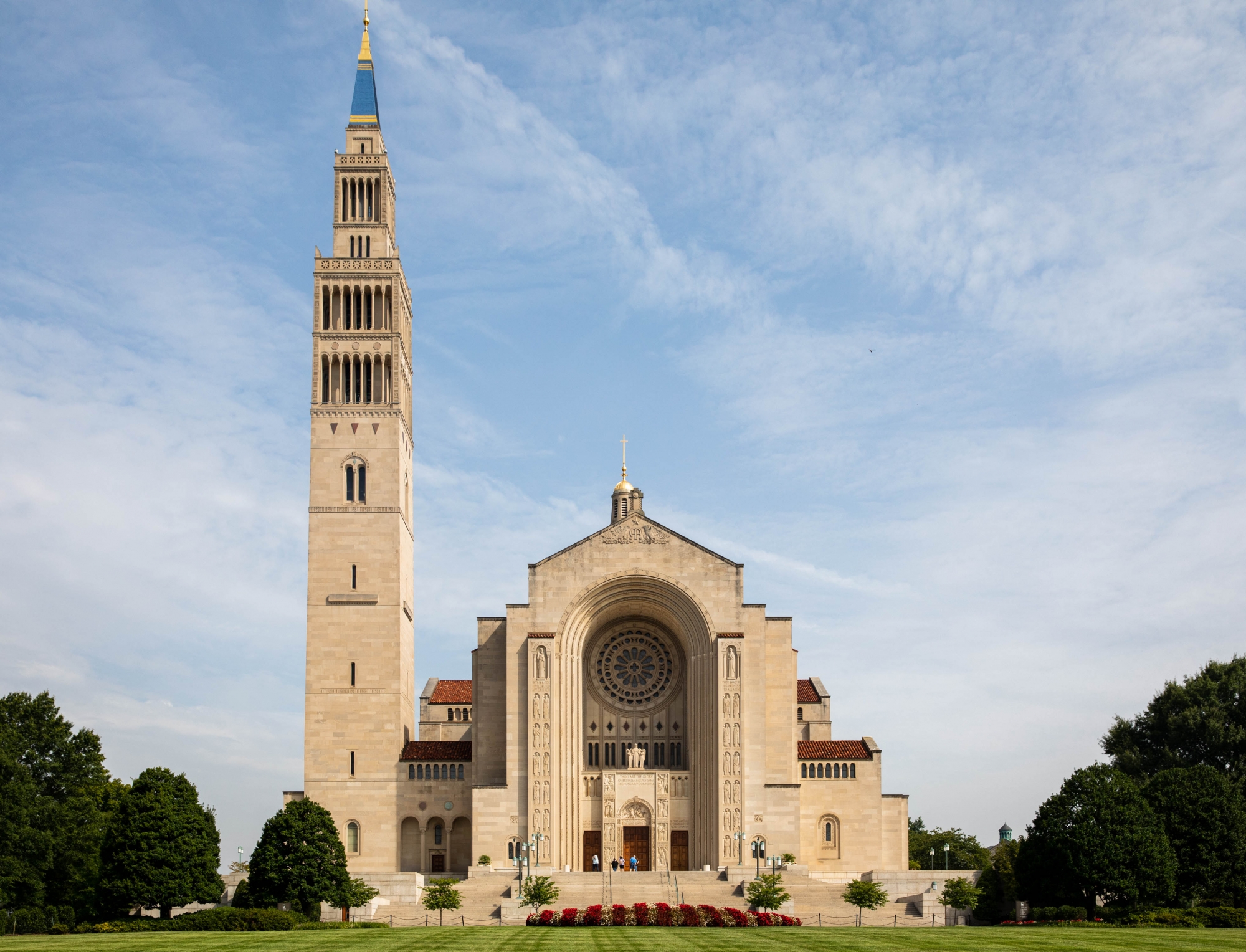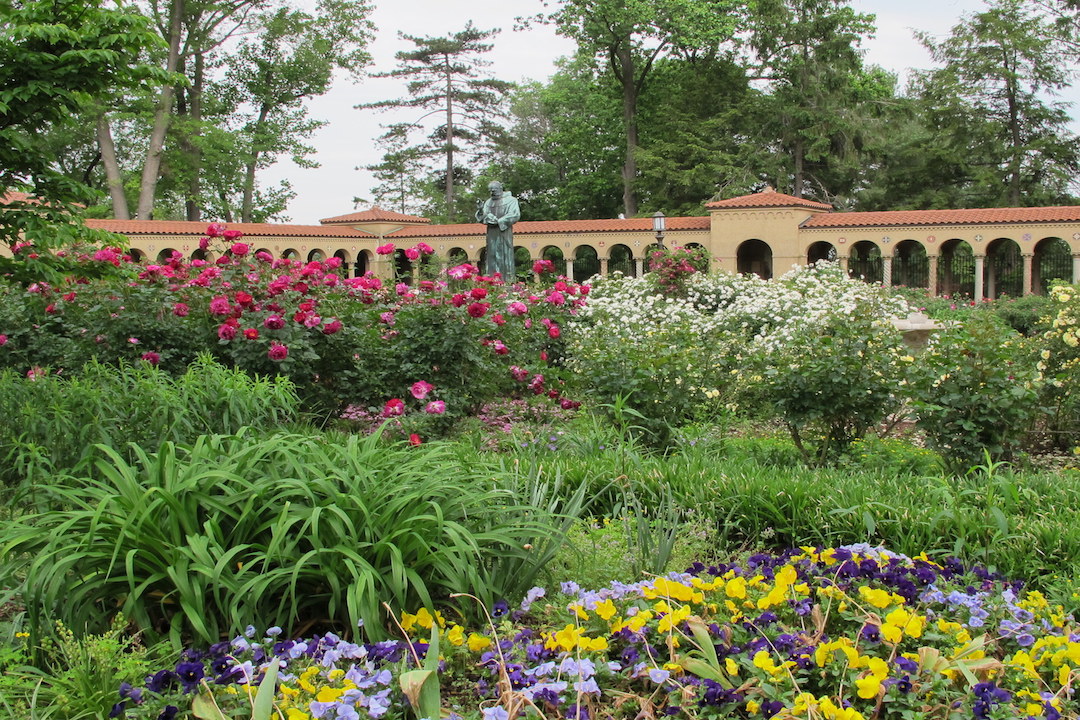Washington, D.C., is more than the seat of the national government. The DMV—the District of Columbia, Maryland and Virginia—is home to broad, diverse communities and neighborhoods that offer history, good eats, parks and waterfronts—much of it a quick Metro ride away. Getting to Know the DMV offers a glimpse of selected neighborhoods.
The neighborhood’s two defining icons—the tower and dome façade of the Basilica of the National Shrine of the Immaculate Conception and the bold white “BROOKLAND” sign painted across nearly two stories of the Brookland Works building—represent the neighborhood’s rich history and its recent and upcoming developments. New establishments and a lively arts scene merge with small local businesses and deep-rooted Catholic history to create a Northeast community with strong ties.
History
Brookland began to take shape as a residential suburb in the 1880s when nearly 150 acres of land owned by Col. Jehiel Brooks, for whom the neighborhood is named, was sold and divided for the development of tracts of middle-class homes.
Residential development brought the Baltimore and Ohio Railroad and other public transportation to the area, connecting it with downtown. Newcomers flocked to the area for its tree-lined streets and large single-family Victorian, Colonial Revival and Craftsman homes. Now located on Metro’s Red Line, the diverse and developing Brookland neighborhood is full of history and community character.

The Basilica of the National Shrine of the Immaculate Conception is the country’s largest Roman Catholic church in the United States. Annually, it attracts nearly 1 million pilgrims and tourists. (Logan Werlinger/GW Today)
What to Do:
Get Artsy
The neighborhood’s brick-paved Arts Walk (716 Monroe St. NE) is a creative hub for the city, hosting 27 small shops, galleries and studios belonging to local painters, potters and crafters. While each has its own schedule, many are open Saturdays from 10 a.m. to 4 p.m. for you to find one-of-a-kind art, catch artists at work or even create your own masterpieces. Follow the Arts Walk Instagram to keep up with upcoming events. Nonprofit Dance Place offers up to 100 performances a year and a variety of workshops, or you can catch a show at Catholic University’s Hartke and Callan theatres.
Explore the Neighborhood’s Religious History
Home to Catholic University of America since 1887, Brookland’s collection of Catholic-inspired architecture, colleges, schools, convents and seminaries has earned it the nickname “Little Rome.” This cluster of Catholic institutions secured the neighborhood a visit from Pope Francis during his 2015 visit to Washington, D.C. Tour some of the most popular sites:
- Basilica of the National Shrine of the Immaculate Conception (400 Michigan Ave. NE)
Take a guided or self-guided tour of the largest Roman Catholic church in North America and one of the largest in the world, which welcomes about 1 million visitors annually. - Franciscan Monastery of the Holy Land of America (1400 Quincy St. NE)
A timeless way of life is visible at this peaceful cloister, where brown-robed monks guide tours of the monastery’s 42 acres of gardens containing hundreds of roses, outdoor replicas of Holy Land shrines and indoor relics. - Saint John Paul II National Shrine (3900 Harewood Rd. NE)
Explore the life of Pope John Paul II through nearly a dozen gallery exhibits featuring artifacts, personal belongings and interactive displays.
See Historic Sites
After World War II, Brookland became a popular neighborhood for affluent African Americans looking for housing that was not restricted to whites only. Catholic University professors lived there as well as quite a few Howard University faculty. Today, it remains a racially diverse neighborhood with a history of social activism. Pass these historic places while in the area:
- Brooks Mansion (901 Newton St. NE)
The former estate of the neighborhood’s founding family is now home to D.C.’s public access television station, DCTV. Become a member and take advantage of opportunities to learn, create and share media through DCTV’s training courses in media production. - Ralph Bunche House (1510 Jackson St. NE)
Part of the self-guided African American Heritage Trail, this home was designed by prominent African American architect Hilyard Robinson for Ralph Bunche, a Howard University political science department chair who was the first person of color to win a Nobel Peace Prize. - Newton Theatre (3601 12th St. NE)
This 1,007-seat theater opened in 1937, when movie-going drifted from downtown venues to neighborhood theaters. In 1979, the theater closed and served as a rock concert venue until the mid 1980s. Today, the historic building houses a CVS pharmacy.

The gardens of the Franciscan Monastery offer a serene setting on the 42-acre site, which was founded in 1899. (Photo Courtesy of dcgardens.com)
Where to Eat:
For something to sip while walking the neighborhood, stop in at Cool Coffee (3901 12th St. NE) or local mainstay Zeke’s, hosted inside Right Proper Brewing Company (920 Girard St. NE)—a full production brewery where visitors can schedule a tour or just enjoy the tasting room.
Emma’s Torch (2212 Rhode Island NE) offers tasty breakfast and lunch options that support a powerful mission: providing in-depth culinary and job training for refugees to ease the transition to a new country. Grab a meal, snack or cocktail at local bookstore and café chain Busboys and Poets’ Brookland outpost (625 Monroe St. NE). Locals also recommend Chadol Korean BBQ (630 Rhode Island Ave. NE, Unit 2B) and Krystal Tex-Mex (3629 12th St. NE)
In the evening, neighborhood favorites include The Dew Drop Inn (2801 8th St NE), which hosts Lazy Bones Pizza, live music and multiple weekly trivia options. Or sample upscale date night options at Primrose (3000 12th St. NE) and craft cocktails at Alegria (670 Rhode Island NE).

The brick-paved paths of Brookland's Monroe Street Market lead visitors through a collection of local art studios and galleries. (Logan Werlinger/GW Today)
How to Get There:
From Foggy Bottom
- Metro: From the Farragut North Metro Station, take the Red Line toward Glenmont to arrive at the Brookland-CUA stop. Or, from Foggy Bottom-GWU, take the Orange Line toward New Carrolton or the Silver Line toward Largo Town Center, then transfer to the Red Line toward Glenmont at Metro Center to arrive at Brookland.
- Bus: Catch the D74 toward Rhode Island Avenue at the 23rd & I Street stop (outside the Bank of America, right across from the hospital). But we recommend Metro—the ride to Brookland Station/Bus Bay J takes about an hour.
Or from the Foggy Bottom-GWU station take the Orange line toward New Carrolton or the Silver line toward Largo Town Center and transfer to the Red line toward Glenmont at Metro Center to arrive at the Brookland-CUA stop.


